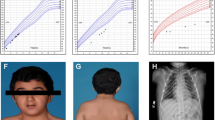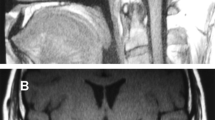Abstract
The LHX3 LIM-homeodomain transcription factor gene is required for normal pituitary and motoneuron development. LHX3 mutations are associated with growth hormone, prolactin, gonadotropin, and TSH deficiency; abnormal pituitary morphology; and may be accompanied with limited neck rotation and sensorineural hearing loss. We report on a boy, who presented with hypoglycemia in the newborn period. He is the second child of healthy unrelated parents. Short neck, growth hormone deficiency, and central hypothyroidism were diagnosed at a general pediatric hospital. Growth hormone and levothyroxine treatment were started, and blood sugar normalized with this treatment. On cerebral MRI, the anterior pituitary gland was hypoplastic. Sensorineural hearing loss was diagnosed by auditory testing. During follow-up, six repeatedly low morning cortisol levels (<1 μg/dl) and low ACTH levels (<10 pg/ml) were documented, so ACTH deficiency had developed over time and therefore hydrocortisone replacement was started at 1.5 years of age. Mutation analysis of the LHX3 gene revealed a homozygous stop mutation in exon 2: c.229C>T (CGA > TGA), Arg77stop (R77X). A complete loss of function is assumed with this homozygous stop mutation. We report a novel LHX3 mutation, which is associated with combined pituitary hormone deficiency including ACTH deficiency, short neck, and sensorineural hearing loss. All patients with LHX3 defects should undergo longitudinal screening for ACTH deficiency, since corticotrope function may decline over time. All patients should have auditory testing to allow for regular speech development.


Similar content being viewed by others
References
Agrawal G, Bhatia V, Cool S, Thomas PQ (2000) Adrenocorticotropin deficiency in combined pituitary hormone deficiency patients homozygous for a novel PROP1 deletion. J Clin Endocrinol Metab 85:4556–4561
Bach I, Rhodes SJ, Pears RV, Heinzel T, Gloss B, Scully KM, Sawchenko PE, Rosenfeld MG (1995) P-Lim, a LIM homeodomain factor, is expressed during pituitary organ and cell commitment and synergizes with Pit-1. Proc Natl Acad Sci USA 92:2720–2724
Bhangoo APS, Hunter CS, Savage JJ, Anhalt H, Pavlakis S, Walvoord EC, Ten S, Rhodes SJ (2006) A novel LHX3 mutation presenting as combined pituitary hormonal deficiency. J Clin Endocrinol Metab 91:747–753
Bottner A, Keller E, Kratzsch J, Stobbe H, Weigel JF, Keller A, Hirsch W, Kiess W, Blum WF, Pfaffle RW (2004) PROP1 mutations cause progressive deterioration of anterior pituitary function including adrenal insufficiency: a longitudinal analysis. J Clin Endocrinol Metab 89:5256–5265
Kelberman D, Dattani MT (2006) The role of transcription factors implicated in anterior pituitary development and in the aetiology of congenital hypopituitarism. Ann Med 38:560–577
Kriström B, Zdunek AM, Rydh A, Jonsson H, Sehlin P, Escher SA (2009) A novel mutation in the LIM homeobox 3 gene is responsible for combined pituitary hormone deficiency, hearing impairment, and vertebral malformations. J Clin Endocrinol Metab 94:1154–1161
Lamesch C, Neumann S, Pfaffle R, Kiess W, Paschke R (2002) Adrenocorticotrope deficiency with clinical evidence for late onset in combined pituitary hormone deficiency caused by a homozygous 301–302delAG mutation of the PROP1 gene. Pituitary 5:163–168
Netchine I, Sobrier M-L, Krude H, Schnabel D, Maghnie M, Marcos E, Duriez B, Cacheux V, Moers AV, Goossens M, Gruters A, Amselem S (2000) Mutations in LHX3 result in a new syndrome revealed by combined pituitary hormone deficiency. Nat Genet 25:182–186
Pfaeffle RW, Savage JJ, Hunter CS, Palme C, Ahlmann M, Kumar P, Bellone J, Schoenau E, Korsch E, Bramswig JH (2007) Four novel mutations of the LHX3 gene cause combined pituitary hormone deficiencies with or without limited neck rotation. J Clin Endocrinol Metab 92:1909–1919
Rajab A, Kelberman D, de Castro SCP, Biebermann H, Shaikh H, Pearce K, Hall CM, Shaikh G, Gerrelli D, Grueters A, Krude H, Dattani MT (2008) Novel mutations in LHX3 are associated with hypopituitarism and sensorineural hearing loss. Hum Mol Genet 17:2150–2159
Seidah NG, Barale JC, Marcinkiewicz M, Mattei MG, Day R, Chretien M (1994) The mouse homeoprotein mLIM-3 is expressed early in cells derived from the neuroepithelium and persists in adult pituitary. DNA Cell Biol 13:1163–1180
Sloop KW, Walvoord EC, Showalter AD, Pescovitz OH, Rhodes SJ (2000) Molecular analysis of LHX3 and PROP-1 in pituitary hormone deficiency patients with posterior pituitary ectopia. J Clin Endocrinol Metab 85:2701–2708
Tsuchida T, Ensini M, Morton SB, Baldassare M, Edlund T, Jessell TM, Pfaff SL (1994) Topographic organization of embryonic motor neurons defined by expression of LIM homeobox genes. Cell 79:957–970
Conflict of interest
The authors confirm that there is no conflict of interest.
Author information
Authors and Affiliations
Corresponding author
Rights and permissions
About this article
Cite this article
Bonfig, W., Krude, H. & Schmidt, H. A novel mutation of LHX3 is associated with combined pituitary hormone deficiency including ACTH deficiency, sensorineural hearing loss, and short neck—a case report and review of the literature. Eur J Pediatr 170, 1017–1021 (2011). https://doi.org/10.1007/s00431-011-1393-x
Received:
Accepted:
Published:
Issue Date:
DOI: https://doi.org/10.1007/s00431-011-1393-x




